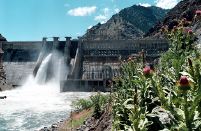forum
library
tutorial
contact

Feds Want Idaho Water for Salmon
by Rocky BarkerThe Idaho Statesman, June 8, 2001
|
the film forum library tutorial contact |

|
Feds Want Idaho Water for Salmonby Rocky BarkerThe Idaho Statesman, June 8, 2001 |
Idaho Power: Flushing fish will hurt consumers
 A federal agency wants Idaho Power Co. to flush a third of the water in Brownlee Reservoir downriver before the end of July to aid endangered fall chinook salmon.
A federal agency wants Idaho Power Co. to flush a third of the water in Brownlee Reservoir downriver before the end of July to aid endangered fall chinook salmon.
If federal dam regulators agree, electricity rates for Idaho Power's 384,000 customers could soar even higher this year. The National Marine Fisheries Service said the water is needed to increase drought-reduced flows for the late migrating chinook.
"NMFS wants to boost our customers' rates by taking control of the Hells Canyon project and running it for fish without regard for the energy needs of Idaho," said John Prescott, Idaho Power vice president of generation.
Fisheries officials say Idaho Power would not be flushing significantly more water than it has during the last five years for salmon.
"It's a little more front-loaded to July," said Ritchie Graves, a fisheries service biologist.
The big difference is that Idaho Power used to be reimbursed for flushing water for salmon. The fisheries service wants the Federal Energy Regulatory Commission, the agency that licenses Idaho Power's dams, to order the flush without compensation.
Even though record numbers of adult hatchery salmon are returning to Idaho this year, drought conditions are seriously impeding the migration of juvenile salmon to the Pacific. That means that the number of wild salmon expected to return in two and three years could be back to the critically low numbers experienced in the mid-1990s.
"Some stocks are in dire straits, and low outmigration survival would put them at an increased risk of extinction," wrote Brian Brown, the fisheries service's assistant regional administrator.
The fisheries service wants Idaho Power to release 360,000 acre-feet of water from Brownlee for salmon. An acre-foot is the amount of water that would flood an acre of land one foot deep. The total amount would be enough water to flush a toilet 29.3 billion times.
Because the company still will be able to produce electricity with the water when it is released, the impact on electric rates is still unknown.
Idaho Power was granted an average 25 percent rate increase in May because of low water and rising wholesale prices.
Idaho Power and state government officials challenge the idea that releasing reservoir water helps salmon. They say it's a drop in the bucket compared with the natural flows of the river, even in a drought year.
The fisheries service scientists say their research shows benefits for both spring-summer and fall chinook. But fall chinook show the most benefit because flows are especially low in the summer, and water temperatures are higher when the fall chinook migrate beginning in early July.
Earlier this spring, the Independent Science Advisory Board, funded by Congress, said more studies were needed to determine the extent of benefits from augmenting river flows from Idaho reservoirs. But they supported continued flushes for fall chinook.
"Higher flow appears to benefit survival, whatever the actual cause," they wrote in their report.
Idaho political leaders oppose any unilateral federal control over Idaho water. Sen. Mike Crapo has asked U.S. Commerce Secretary Donald Evans to withdraw the fisheries service request. Evans has authority over the fisheries service.
FERC would violate state water law and "willing buyer, willing seller" provisions already agreed upon by federal officials, Crapo said.
"NMFS' approach is unconscionable and must be quickly corrected," the Idaho Republican said.
Mark Robinson, director of FERC's office of energy projects, asked both the fisheries service and Idaho Power for more information before the commission rules on the request. Idaho Power challenges the agencies' authority to reopen its current license and order the flush.
The license for the Hells Canyon dams expires in 2005. Idaho Power is preparing its application for a new license.
The complex includes Brownlee, Oxbow and Hells Canyon dams. Together the dams produce 737 megawatts of electricity annually, enough for 464,000 homes.
Salmon are an icon of the wild character of the Pacific Northwest and still provide economic benefits to fishermen and related businesses and spiritual sustenance to the region's Indians.
Idaho Power officials said the salmon's migration problems are caused by the four lower Snake dams in Washington. Federal officials chose not to propose breaching those four dams in December.
Idaho Power's dams cut off migration to 90 percent of the fall chinook's historic habitat in the late 1950s. But the company has offset those losses with hatcheries and by keeping fall and winter flows stable below the dams to protect salmon eggs.
"Now NMFS wants our customers to also pay for the impact the four lower Snake federal dams have had on migrating fish, without clear evidence that Idaho's water would even help their situation," Prescott said. "We think the federal government should fix its own problems and quit trying to raid Idaho's water."
What this means to Idaho Power customers If approved, the flush of water in July could mean higher electric rates.
What it means to salmon Increased river flows aid the migration to the ocean for fall chinook salmon.
Related Links:
Company Opposes Fisheries Service Attempt To Grab Idaho Water, Idaho Power press release
American Rivers
Idaho Power Co.
NW Council
learn more on topics covered in the film
see the video
read the script
learn the songs
discussion forum
